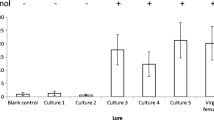Abstract
The production of a gregarization pheromone has been postulated in locusts, with effects on melanization of the hopper cuticle and increased chiasma frequency during meiosis in the adult on crowding or gregarization. Lack of chiasma-inducing effect of the pheromone on albino strains is correlated with the absence or deficiency of some of the products of the metabolic pathways of tyrosine. Some of these products, commercially obtainable, are the amino acids phenylalanine and tyrosine leading to both the melanization and sclerotization pathways; dopamine formed from dopa in the lastnamed pathway; three products of dopamine i.e. protocatechuic acid, noradrenaline and adrenaline. The injection of solutions of these metabolites into the haemolymph of solitary hoppers has shown that only dopa to some extent but noradrenaline to a large extent are effective in raising chiasma frequency in solitarised individuals of normal-coloured strains of Locusta, while in two albino strains, which differ genetically, the injection of dopa, dopamine, protocatechuic acid and noradrenaline proved effective; phenylalanine was effective in only one of these albino strains, while adrenaline was effective in neither. The chiasma-inducing effect of noradrenaline, common to the three strains, is accompanied in the normal-coloured strain by a greater retention of dark coloration during solitarization and by some attainment of the crowded type of morphometric ratios which is a third physical criterion of gregarization. The genetic blocks to the physical criteria of gregaria in the albino strains lie at the immediate level of dopa production or previous to this reaction; it may be construed that such a block in the solitaria of normal-coloured strains also lies at this early level, in this case being induced by too low a pheromone concentration.
Similar content being viewed by others
References
Gillett, S.: Airborne factor affecting the grouping behaviour of locusts. Nature (Lond.) 218, 782–783 (1968).
Gunn, D. L., and P. Hunter-Jones: Laboratory experiments on phase differences in locusts. Anti-Locust Bull. (Lond.) No 12, p. 35 (1952).
Jones, B. M., and W. Sinclair: Induction of melanin patterns and of hardening as separate processes in the cuticle of albino locusts with internally absorbed phenol substrates. Nature (Lond.) 181, 926–927 (1958).
Karlson, P., u. P. Herrlich: Zum Tyrosinstoffwechsel der Insekten. XVI. Der Tyrosinstoffwechsel der Heuschrecke, Schistocerca gregaria Forsk. J. Ins. Physiol. 11, 79–89 (1965).
—, u. A. Schweiger: Zum Tyrosinstoffwechsel der Insekten. IV. Das Phenoloxydase System von Calliphora erythrocephala und seine Beeinflussung durch das Hormon Ecdyson. Hoppe-Seylers Z. physiol. Chem. 323, 199–210 (1961).
—, and C. E. Sekeris: N-acetyl-dopamine as sclerotizing agent of the insect cuticle. Nature (Lond.) 195, 183–184 (1962).
Malek, S. R. A.: Sclerotization and melanization, two independent processes in the cuticle of the desert locust. Nature (Lond.) 180, 237 (1957).
Mason, H. S.: Comparative biochemistry of the phenolase complex. Advanc. Enzymol. 16, 105–184 (1955).
Nolte, D. J.: A pheromone for melanization of locusts. Nature (Lond.) 200, 660–661 (1963).
—: Phase transformation and chiasma formation in locusts. Chromosoma (Berl.) 21, 123–139 (1967).
—: The chiasma-inducing pheromone of locusts. Chromosoma (Berl.) 23, 346–358 (1968).
Pryor, M.G.M.: Sclerotization. In: Comparative biochemistry, vol. IV, p.371–394. New York: Academic Press 1964.
Ramwell, P. W., H. S. A. Sherratt, and B. E. Leonard: The physiology and pharmacology of phenolic compounds in animals. In: Biochemistry of phenolic compounds, p. 457–510. New York: Academic Press 1964.
Schlossberger-Raecke, I., u. P. Karlson: Zum Tyrosinstoffwechsel der Insekten. XIII. Radioautographische Lokalisation von Tyrosinmetaboliten in der Cuticula von Schistocerca gregaria Forsk. J. Ins. Physiol. 10, 261–266 (1964).
Schweiger, A., u. P. Karlson: Zum Tyrosinstoffwechsel der Insekten. X. Die Aktivierung der Präphenoloxydase und das Aktivator-Enzym. Hoppe-Seylers Z. physiol. Chem. 329, 210–221 (1962).
Sekeris, C. E.: Sclerotization in the Blowfly imago. Science 144, 419–420 (1964).
Thomson, R. H.: Melanins. In: Comparative biochemistry, vol. III, p. 727–753. New York: Academic Press 1962.
Author information
Authors and Affiliations
Rights and permissions
About this article
Cite this article
Nolte, D.J. Chiasma-induction and tyrosine metabolism in locusts. Chromosoma 26, 287–297 (1969). https://doi.org/10.1007/BF00326523
Received:
Issue Date:
DOI: https://doi.org/10.1007/BF00326523




